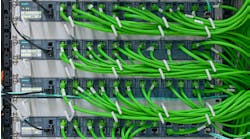Smart Industry: What is the purpose of the Industrial IoT Lab?
Brett: The lab is a working showcase for collaboration and innovation. We needed a space that would let engineers, researchers and data scientists from a variety of companies meet to work on technologies, platforms and reference architectures that combine to form more complete IIoT solutions. Partner ecosystems are critical to success in the IIoT space, as no company is really going to be able to go it alone. This lab lets a variety of technology companies validate interoperability between adjacent technologies such as data acquisition, control, processing, communication, analytics, mobile software apps and more.
An example of innovation and interoperability in the lab is a developing standard such as TSN, an Ethernet-based standard that adds deterministic communication. In the two days following the opening ceremony, NI hosted a plugfest in the lab with 23 engineers from 10 different companies working on TSN-product compatibility.
Smart Industry: Who does it serve?
Brett: This lab is designed to foster collaboration among companies interested in working on IIoT technologies while strengthening partnerships. Many collaborators in the lab came from interactions with organizations such as the Industrial Internet Consortium (IIC) and Avnu, while others have come from industry networking. It also serves as a great showcase for the domain experts that are facing these problems in industry, as it provides a lab environment to test out potential ideas and solutions.
Smart Industry: Why now? Is there a trend or shift in industry/manufacturing that prompts this initiative?
Brett: Many companies share the vision of how IIoT technologies can change the way businesses operate, but without cooperation at the technology level venders run the risk ofSmart Industry: The lab is "designed with flexibility for the future." What does that mean?
Brett: We had our set list of equipment and testbed demonstrators in the lab that would be installed on Day 1, but we also knew that more technologies and applications would be added to these efforts: microgrid, flexible manufacturing, asset monitoring. Planning for an unknown future is more difficult, but we felt it was important to support the innovation aspect of the lab. Some examples of lab features that support flexibility include an enlarged electrical and HVAC system that can handle more loads from future equipment both in the lab and the server room, multiple three-phase power outlets in the room (potentially for manufacturing equipment), pre-run empty conduit between the server room and the lab for more network ports, and a power outlet/distribution design in the walls that makes it easier to add or move electrical drops without needing to rework drywall.
Smart Industry: What element of the lab most excites you?
Brett: I’ll give you two different angles.
I am excited about the engagement from all of the different companies involved. We have been talking about these demos and the lab for a while, but once people see it in person or talk to someone that has, all these new ideas come up for ways we can work on or promoteThe other aspect I am excited about is the data that we are able to generate and provide access to in this lab. In short, the lab has “things” which we can use to build/prove solutions. We have access to lab assets like a programmable microgrid and pump, as well as facility assets like the chilled-water pumps that drive the HVAC system on NI’s campus and all the power usage in the lab. (Every circuit in the lab is monitored.) All of this vibration, temperature, and electrical data is real-world data and something we can provide to lab collaborators for work on algorithms and other software technologies. We are still finalizing the VPN installation for the lab’s private network, but once complete, companies from around the world will be able to work with NI and access real data from the lab and around NI’s campus. From an IIoT perspective, providing connections with edge assets (sensor measurements/controlling actuators) is an NI expertise and one of our technology contributions to the ecosystems.



